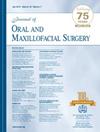Effectiveness of Concentrated Growth Factor on Improving Postoperative Comfort in Patients Undergoing Coronectomy for Impacted Lower Third Molars: A Double-Blinded Split-Mouth Randomized Controlled Clinical Study
IF 2.3
3区 医学
Q2 DENTISTRY, ORAL SURGERY & MEDICINE
引用次数: 0
Abstract
Background
Following coronectomy, pain and edema are adverse side effects. Concentrated growth factor (CGF) is recognized for its potential to enhance wound healing, reduce inflammation and may help to improve postoperative comfort following coronectomy.
Purpose
The study purpose was to measure and compare postoperative pain and edema between CGF and control treatments in patients undergoing bilateral coronectomies.
Study Design, Setting, and Sample
In this split-mouth, double-blind, randomized controlled study conducted at Ege University Faculty of Dentistry, Department of Oral and Maxillofacial Surgery in Izmir, Turkey, patients aged 18 to 65 years at risk of mandibular nerve injury underwent bilateral coronectomy. Patients over 65 years of age or those with systemic conditions contraindicating surgery were excluded. Patients and the researcher responsible for data collection and analysis were blinded to the intervention.
Independent Variable
The independent variable was wound management. Within subjects, the treatment sides were randomly assigned to CGF treatment or control.
Main Outcome Variable
The outcome variable was postoperative comfort measured using pain and edema. Pain was measured using the visual analog scale for 7 days after surgery. Edema was quantified in millimeters in 3 planes preoperatively and on postoperative days 2 and 7.
Covariates
Age, sex, and depth of impaction were covariates.
Analyses
The conformity of edema measurements to normal distribution was assessed with the Shapiro-Wilk test, analysis of variance for repeated measures and Bonferroni correction, and supported by paired two-sample t test (significant interaction); since pain levels did not fit the normal distribution (ordinal scale), the nonparametric Brunner and Langer model (LD-F2) and Benjamini-Hochberg procedure were used. Statistical significance was defined as (P < .01).
Results
The sample included 35 subjects, comprising 12 (34.3%) males and 23 (65.7%) females, with a mean age of 32.7 ± 11.42 (standard deviation). Visual analog scale scores were significantly lower on the CGF side for the first 6 days (P < .001) but not on day 7 (P = .6). Postoperative second day edema was statistically significantly lower in the 2 planes on the CGF side (P < .001, P = .007, P = .8) but not on day 7 in any plane (P = .5, P = .8, P = .1).
Conclusions and Relevance
Our study shows that CGF enhances postoperative comfort by minimizing pain and edema. Additional interventions may be necessary for patients undergoing coronectomy due to the potential for significant postoperative discomfort.
浓缩生长因子改善下三磨牙冠切除术患者术后舒适度:一项双盲裂口随机对照临床研究。
背景:冠状切除术后的不良反应是疼痛和水肿。浓缩生长因子(CGF)被认为具有促进伤口愈合、减少炎症的潜力,并可能有助于改善冠状切除术后的术后舒适度。目的:研究目的是测量和比较双侧冠状动脉切除术患者术后CGF和对照治疗的疼痛和水肿。研究设计、环境和样本:在土耳其伊兹密尔埃格大学牙科学院口腔颌面外科进行的这项裂口、双盲、随机对照研究中,年龄在18至65岁之间、有下颌神经损伤风险的患者接受了双侧冠状切除术。年龄超过65岁或有全身疾病禁忌手术的患者被排除在外。患者和负责数据收集和分析的研究人员对干预措施不知情。自变量:自变量为伤口管理。在受试者中,治疗组被随机分配到CGF治疗组或对照组。主要结局变量:结局变量为术后舒适度,以疼痛和水肿来衡量。术后7天用视觉模拟量表测量疼痛。术前及术后第2、7天分别在3个平面以毫米为单位量化水肿。协变量:年龄、性别、嵌塞深度为协变量。分析:水肿测量值与正态分布的符合性采用Shapiro-Wilk检验、重复测量的方差分析和Bonferroni校正,并采用配对双样本t检验(显著相互作用);由于疼痛水平不符合正态分布(有序尺度),因此使用非参数Brunner and Langer模型(LD-F2)和Benjamini-Hochberg程序。结果:共纳入35例受试者,其中男性12例(34.3%),女性23例(65.7%),平均年龄32.7±11.42岁(标准差)。结论和相关性:我们的研究表明,CGF通过减少疼痛和水肿来提高术后舒适度。由于潜在的术后明显不适,接受冠状切除术的患者可能需要额外的干预措施。
本文章由计算机程序翻译,如有差异,请以英文原文为准。
求助全文
约1分钟内获得全文
求助全文
来源期刊

Journal of Oral and Maxillofacial Surgery
医学-牙科与口腔外科
CiteScore
4.00
自引率
5.30%
发文量
0
审稿时长
41 days
期刊介绍:
This monthly journal offers comprehensive coverage of new techniques, important developments and innovative ideas in oral and maxillofacial surgery. Practice-applicable articles help develop the methods used to handle dentoalveolar surgery, facial injuries and deformities, TMJ disorders, oral cancer, jaw reconstruction, anesthesia and analgesia. The journal also includes specifics on new instruments and diagnostic equipment and modern therapeutic drugs and devices. Journal of Oral and Maxillofacial Surgery is recommended for first or priority subscription by the Dental Section of the Medical Library Association.
 求助内容:
求助内容: 应助结果提醒方式:
应助结果提醒方式:


